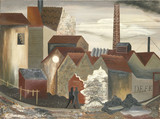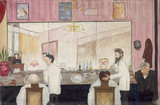Despite his cosmopolitan life and numerous writings on art, Hilaire Hiler’s paintings are not well known to the American public. This is due partly to his long residence abroad and his activities in other fields, including aesthetics, costume history, and psychoanalysis. His paintings evolved from a primitive manner to complete nonobjectivity.
After withdrawing from the University of Pennsylvania’s Wharton School of Finance, Hilaire Hiler (born Hiler Harzberg) studied briefly at the Pennsylvania Academy of the Fine Arts and then went to Paris around 1919 or 1920. There he became an intimate of the Montparnasse circle of artists and literati, numbering among his friends Ezra Pound, Ernest Hemingway, Marcel Duchamp (1881-1968), Man Ray (1890-1976), and Henry Miller. Hiler remained in France for fifteen years, supporting himself at times as a jazz musician. During this time he also painted murals for several nightclubs. He had his first solo exhibition in Paris in 1923 and in New York in 1925. During the late 1920s he began creating cubist-influenced urban views.
In 1934 Hiler returned to the United States, working in San Francisco and then Los Angeles and briefly in the 1940s in Santa Fe; he commissioned Rudolf Schindler to design his Los Angeles studio. His return also marked a switch to American themes, as he created oils, watercolors, rug designs, and lithographs based on the symbols and abstract designs of Native American decorative arts, the Native American way of life, and the landscape they inhabited. From 1936 to 1939 Hiler worked as a mural painter and served as a supervisor on the Works Progress Administration/Federal Art Project in San Francisco, designing entire rooms for the Aquatic Building. These murals offered Hiler the opportunity to express his fascination with color on a large scale. He then became obsessed by color and theories relating color to psychology. He studied psychology with Otto Rank in Paris and briefly maintained a psychotheraputic practice in Los Angeles in 1946 after obtaining a Ph.D. degree at Golden State University.
Starting in the 1930s he wrote numerous books and articles on color; his earliest writings, such as Notes on the Technique of Painting (1932) and Color Harmony and Pigments (1940), were primarily technical manuals. In Los Angeles he lectured on color theory and founded Fremont College, which specialized in teaching color and design theories. More importantly he formulated a concept of "structuralism" that would dominate his art for the rest of his life. In his 1945 manifesto Why Abstract? he explained how in this completely nonrepresentational art he was able to present structure, order, and color in terms of the harmonious relation of a geometric progression.
In 1942 Hiler’s first solo exhibition in many years was held at Frank Perls Gallery in Hollywood; the catalogue essay was written by William Saroyan. Hiler’s continued fascination with dynamics, composition, and color was demonstrated in what he called his psychromatic paintings exhibited in New York and on the West Coast that year.
BIBLIOGRAPHY
Archiv. Am. Art, Hilaire Hiler Papers § Waldemar George (pseud.), Hilaire Hiler et la vision panoramique (Paris: Editions des Quatre Chemins, [1933]) § Henry Miller, "Hiler and His Murals," in The Air-Conditioned Nightmare (New York: New Directions, 1945), pp. 278-82 § Waldemar George (pseud.), Hilaire Hiler and Structuralism: New Conception of Form-Color, English ed. (New York: Wittenborn, 1958), with essays by the artist and Vincent Schmidt, biographical note, bibliography, lists of exhibitions, collections, and murals § Albuquerque, University of New Mexico, Art Museum, Hilaire Hiler, 1898-1966, exh. cat., 1976, with text by Michael Regan and Nicolai Cikovsky, Jr., bibliography.

